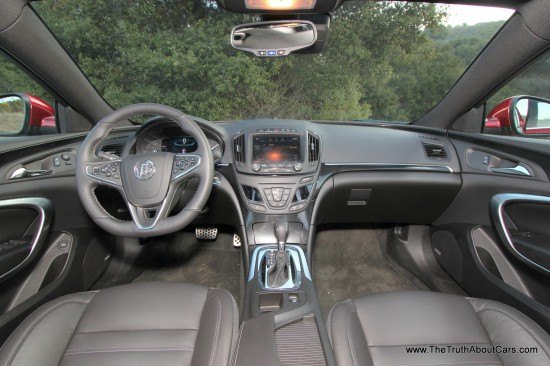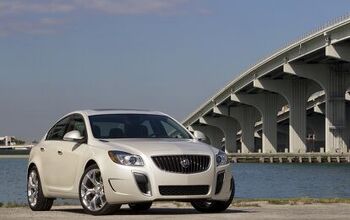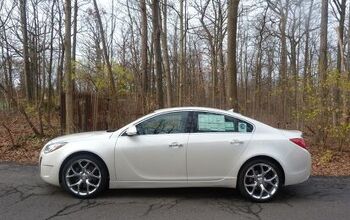Review: 2014 Buick Regal GS AWD (With Video)

In my mind, Volkswagens used to be the “Euro Buick.” Positioned one note above the mass market rabble, VW’s Passat shared parts with Audi’s A4, while the Touareg and Phaeton were luxury cars with a mass market logo on the hood. Then Volkswagen decided this was the wrong strategy for them, so they repositioned VW as the German alternative to Toyota and Chevrolet. This left a gaping hole in the market for shoppers looking to step into a European near-luxury vehicle that flew under the radar. And then Buick stepped in.Buick’s Opel-based product offensive has transformed the brand from Barcalounger wheels for the octogenarian, to a window into the soul of GM’s German brand. This transformation isn’t an easy one as Buick’s problem wasn’t just blue-haired buyers and slinky-soft springs. Buick is the penultimate middle child. Jammed between Chevrolet and Cadillac, brand B’s mission is to give Chevy buyers something to aspire to and Cadillac buyers something to graduate from.
Exterior
When you say “Regal GS” my mind immediately leaps to the fourth-generation Regal (2nd generation W-body) with the supercharged 3.8L V6. When I was car shopping in 2000 I dearly wanted a Regal GS but there were two problems: Buick’s grandmotherly image and the price tag. As a result I bought an entirely different old person car: a Chrysler LHS. But I digress. This GS is an entirely different beast. Buick’s latest middle child is none other than Opel’s largest sedan, the Insignia. Refreshed for the 2014 model year, the differences between the Insignia and the Regal are most pronounced on the exterior where a Buick waterfall grille and logo have been inserted into the same opening as the Opel and ventiports have been added to the hood. And… that’s about it.
Two things are obvious when looking at the Buick Regal: it was designed in Europe and it was designed to to be both a Buick and an Opel from the start. Rather than looking out of place (like the Chrysler 300 to Lancia Thema transition) the Regal looks “meant to be.” Although the Regal is related to the Chevy Malibu, there’s essentially no exterior resemblance. The Regal GS I spent a week in gets the tweaked front and rear bumpers from Opel’s Insigia OPC model which ditches the foglamps for extra ventilation and integrates the exhaust tips into the rear bumper cover. Circling back around to those ventiports: I still think they look silly, but thankfully the Regal has the right number (four) and they are smaller and less conspicuously placed than on other Buick models I could mention.
Interior
2014 brings a new interior to the Regal based around a standard 8-inch touchscreen and new center console. Although you will still find a few hard plastics in the cabin, overall materials quality has improved and is firmly competitive with the Volkswagen CC, Audi A4 and Acura TL. Most cabin touch points feel more premium than the more expensive Lexus ES but the Volvo S60/S80 still lead the segment. Non-GS shoppers can opt for a handsome two-tone interior that combines a brown steering wheel and upper dash with a light grey/tan seats and carpet which would be my preference. GS models however are stuck with a very Germanic black-on-black theme. Part of the GS package is an 8-inch LCD instrument cluster and a chunkier steering wheel with sport grips, soft leather and a flat bottom. The disco dash is not as configurable as Chrysler’s 7-inch unit but the graphics are more modern and the system allows you full access to your media device, something uConnect still lacks.
For reasons unknown Buick chose not to borrow the Recaro seats found in the Insignia OPC, opting instead for more aggressively bolstered versions of the standard seat design. This may be because Buick owners are less likely to need the 5-point harness design, but it is most likely because we Americans are fatter so fewer of us would fit in the narrow seats. My 6-foot and slightly overweight frame fit snugly and comfortably in the front seats but the ceiling in the rear of the Regal proved too low for me to sit without cocking my head to the side. The lack of rear seat headroom was disappointing because the Regal offers several inches more rear leg room than the RWD Cadillac ATS and CTS and three inches more than the Volvo S60 and S80.
Infotainment
Like the LaCrosse, the Regal and the Opel Insignia now uses a modified version of Cadillac’s CUE. For reasons I don’t understand however, Buick doesn’t get Opel’s interesting touchpad with “finger writing” recognition that Opel has been advertising across the pond. I’m guessing this is so that Buick doesn’t step on Cadillac’s toes. Compared to CUE there are a few other changes for Buick-duty. The expensive glass capacitive touchscreen (looks like a modern smartphone) is swapped for a resistive unit that isn’t as crisp or as glare reducing and we have physical buttons for some system features, a marked improvement over Cadillac’s touchscreen only interface. Aside from these charges, the majority of CUE remains.
Like Ford’s MyFord Touch system, IntelliLink is sluggish in general and sometimes totally unresponsive. The software also suffers from unintuitive menu layouts and old-school mapping software that doesn’t jive with the system’s high-resolution screen. Like CUE, some multi-touch gestures are supported, but the different touchscreen is less able to decipher your intent leading to some frustrating moments. On the bright side, CUE’s selling points remain. The system’s voice command system features natural language commands and instead of treating the USB ports as separate inputs, the system aggregates them into one large music library allowing you to voice command songs without specifying the device.
Drivetrain
Nestled sideways under the hood is the same 2.0L direct-injection turbocharged four-cylinder engine that the Cadillac ATS and CTS use. Good for 259 horsepower and 295 lb-ft of twist, this is the same engine that you find in the “regular Regal.” That’s right, no longer does “GS” stand for “more power.” This means the GS looses 11 ponies vs 2013 but the turbo Regal gains 39 vs 2013. To differentiate things, GM does alter the torque curve to deliver all 295 twists at 2,500 RPM instead of 3,000 in the non-GS model. GM hasn’t completely ruled out the 325 horse 2.8L twin-turbo V6 the Insignia OPC uses for the American market, but I’d call it a long shot.
GS shoppers can choose either a 6-speed manual transaxle or a 6 speed automatic, but if you want the optional Haldex AWD system you’re forced to select the auto. Although the GS uses the same AWD system as the regular Regal AWD, the engineers tossed in an electronically controlled limited slip rear differential. GS trims also bump the suspension up a notch by combining GM’s HiPer Strut technology with active dampers on all four corners. The suspension offers three modes: normal, sport and GS. The feel ranges from European family sedan to firm.
Drive
GM’s HiPer Strut suspension is designed to bring the steering axis more in line with the tire centerline, something you typically find in rear-wheel drive cars. Aligning the axis more closely results in better tracking, less torque steer and a front tire with a more consistent camber across the suspension’s travel. Versus the outgoing model, the front tires contact patch is improved in corners when the front suspension is loaded resulting in higher grip. Coupled with an AWD system that sends 50% of the power to the rear under hard acceleration, we get the first Buick in a long time with virtually zero torque steer.
The downside to the trendy new steering knuckle design is feel. Steering is very precise but suffers from the same Novocaine-laced feedback as everything else out there with electric power steering. Despite a 58/42 F/R weight distribution, the Regal GS has impeccable manners up to 9/10ths, where it starts to lose composure. Trouble is, without steering feedback it’s hard to tell where 9/10ths is located. In contrast, the Volvo S60 T6 AWD and S80 T6 AWD offer less grip but more feel.
Driving a FWD Regal back to back with our AWD tester, I kept thinking “there’s just something I dislike about the FWD model”. As it turns out, there is a reason the FWD Regal felt unsettled in the rear over broken pavement, the AWD model gets an entirely different “H-Link” independent rear suspension. Coupled with the active dampers, the Regal felt well composed on a variety of road surfaces despite being tuned firmer than the rest of the American and Swedish competition. Rather than being the softest entry in the segment, the GS is among the firmer.
Put your foot to the floor and the GS will run to 60 in 6.7 seconds, exactly the same as the W-Body Regal GS I remember with fond memories. The difference is, the W-Body’s torque steer made the car feel like it was part car, part carnival ride. The 2014 model tracks straight and true with zero drama all the way to a 15.2 second 1/4 mile. Stacking this up with the competition, the Regal is notably slower than the Cadillac CTS/ATS 2.0T and Volvo’s S60 T5 AWD; and a hair slower than the 3.7L Lincoln MKZ, Lexus ES 350 and Acura TL. Despite similar power figures, the Volvo ran to 60 nearly 7/10ths faster which caused me to question my numbers. However, a loaner provided by a local dealer confirmed my findings. The reason seems rooted both in the GS’ gear ratios and the more advantageous torque curve from Volvo’s funky 5-cylinder.
At $37,830 starting, $40,195 with AWD and $44,975 full-loaded, the Regal undercuts the Volvo S60 T5 AWD and Acura TL by a couple thousand across the board (comparably equipped) and is more than $5,000 cheaper than the Lexus ES depending on your configuration. The Acura TL is in its final year of production and is, as you would assume, outclassed by the Regal in most ways. The recently refreshed Volvo delivers better road feel and a slightly more premium interior at the expense of more cash and less grip. The Lexus ES suffers from soft springs, an uncompetitive interior and steep price tag.
Over 611 miles I managed a reasonable 22.1 MPG in the GS which bests the real-world numbers from the V6 competition but comes short of the turbo Caddy and Swede. Why do I keep coming back to Cadillac? Because as hard as GM has tried to keep Chevrolet, Buick and Cadillac from stepping on each other’s toes, the Regal GS is about the same price as the 2014 Cadillac ATS. It’s hard enough to go up against what is probably the second best vehicle GM has ever produced, but it is made doubly hard when there are so many combined Buick/Cadillac dealers. This means you’ll frequently find the Regal GS next to a sharp handling Caddy is on the same lot. Trickier still is the base Cadillac CTS which is slightly cheaper than a loaded GS, and, you guessed it: is often parked right next to the Buick. Buick seems to have finally gotten the hang of being the middle child and in the process they have given not only Chevy owners but Volkswagen owners something to aspire to. That said, I’d be hard pressed to choose the Regal over an ATS 2.0T.
GM provided the vehicle, insurance, and one tank of gas for this review.
Specifications as tested
0-30: 2.67 Seconds
0-60: 6.7 Seconds
1/4 Mile:15.2 Seconds @ 93 MPH
Average observed fuel economy: 22.1 MPG over 611 miles
Interior sound level at 50 MPH: 68.5 dB @ 50 MPH

More by Alex L. Dykes
Latest Car Reviews
Read moreLatest Product Reviews
Read moreRecent Comments
- ChristianWimmer It might be overpriced for most, but probably not for the affluent city-dwellers who these are targeted at - we have tons of them in Munich where I live so I “get it”. I just think these look so terribly cheap and weird from a design POV.
- NotMyCircusNotMyMonkeys so many people here fellating musks fat sack, or hodling the baggies for TSLA. which are you?
- Kwik_Shift_Pro4X Canadians are able to win?
- Doc423 More over-priced, unreliable garbage from Mini Cooper/BMW.
- Tsarcasm Chevron Techron and Lubri-Moly Jectron are the only ones that have a lot of Polyether Amine (PEA) in them.


























































Comments
Join the conversation
Now I'm curious as to what other cars Alex has owned in his lifetime! Also, his videos are some of the better ones on youtube. I suggest you all hit the subscribe button.
If you asked me how much the Regal costs, at a reasonable level of loaded-ness, I would have said $35k. To me, the LaCrosse could fetch $40-45k, but really no more. And the Regal is much more expensive than the Verano, and not much larger, and still FWD. In my mind I can't justify the pricing for this Buick, when there are so many competitive alternatives, even from GM's own stable. Too much overlap.